
.
If you have any comments, observations, or questions about what you read here, remember you can always Contact Me
All content included on this site such as text, graphics and images is protected by U.S and international copyright law.
The compilation of all content on this site is the exclusive property of the site copyright holder.
It's time to make hay. The grass is well grown, nice and leafy. The weather forecast looks good for the week it needs to dry before baling and moved to the barn for storage in the haymow.

Jack and Chester at work in the hayfield.
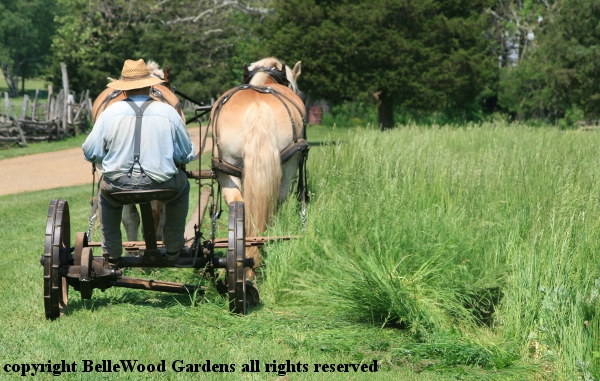
The cutter bar slices easily through the grass stems.

It is hot and somewhat humid today. Every now and then Kevin
gives the team a shady rest break so everyone can cool down.
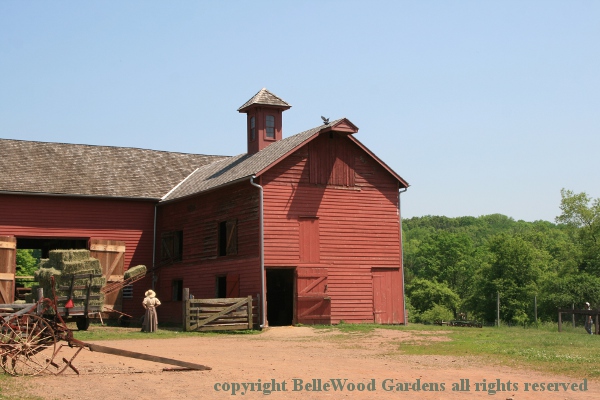
Moving baled hay into the mow. So much is needed! Just think - there are three teams of draft horses, each weighing from 1,500 to 1,800 pounds. They graze on the pastures, are fed some hay and oats, and in winter some corn is added to their feed. And oh yes, there's a team of oxen too. Every day each of the draft animals is fed a half of a small bale of hay - the size that's being loaded into the hay mow. The small bales weigh about 35 to 40 pounds each. So that's about 1,100 bales of hay, close to 20 tons of hay every year.
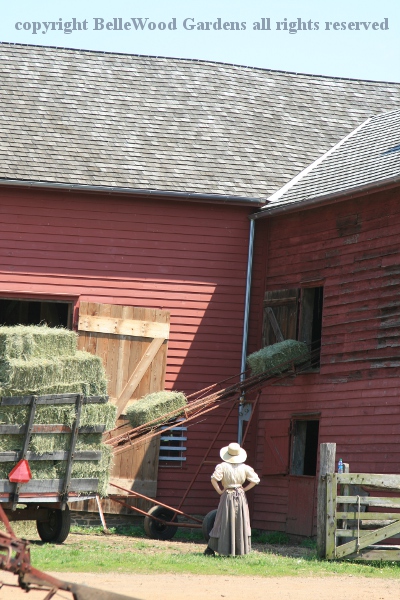
.
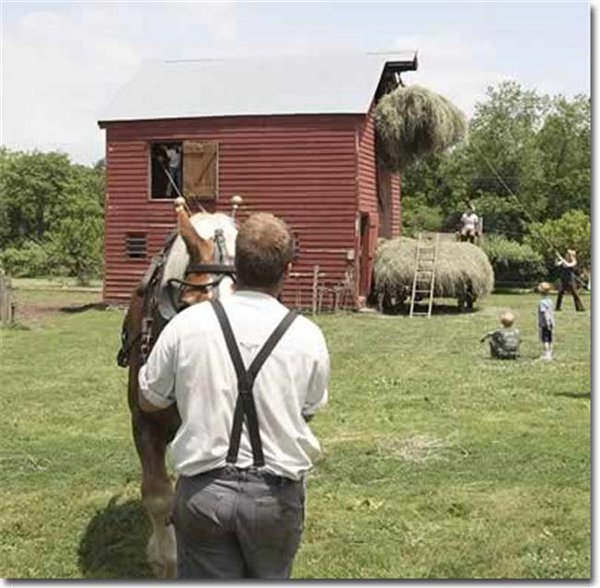
image courtesy of Howell Living History Farm
Sometimes rather than baling the hay is stored loose. Then the hayloft is filled with loose hay from the top of a wagon, hoisted up through a large door usually in the gable end of the building.

It's so hot out today that the teams are rotating in and out of the stable, one team taking a break while another is working. Handsome Belgian mix Jessie was foaled on 22 May 1997 and came to Howell Living History Farm in January 2008. So his birthday was just about a week ago. He and his partner Bill are harnessed up except for their bridles, waiting in the barn with a cooling breeze blowing through until it is their turn to go out to work.
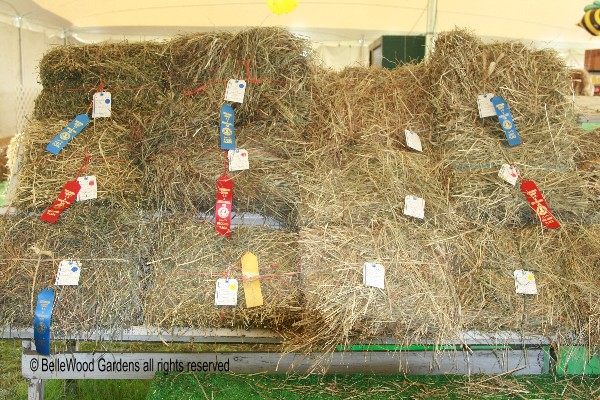
All hay is not the same. In fact, the Hunterdon County 4-H Fair
has a competition class for hay. With ribbons for the winners.
Howell grows several different grasses for their hay making. One is orchard grass, Dactylis glomerata. A high-quality, bunch-type, tall-growing, cool-season perennial grass that provides excellent feed for most classes of livestock. It is one of the most productive cool-season grasses, shade tolerant somewhat drought resistant, with moderate winter hardiness. A versatile grass, it may be used for pasture, hay, green chop, or silage.
Quality of the hay also depends on the age at which the hay is harvested. Hay cut at early maturity is very leafy and has a high nutrient density and palatability. Late cut hay contains coarse, thick stems and fewer leaves. The protein content, digestibility, and palatability declines. Howell also grows timothy grass, Phleum pratense, and clover in combination. Mixing grasses with a legume such as clover has two notable benefits. The clover adds nitrogen to the soil, reducing the amount of fertilizer needed. Also, the combination of timothy grass and clover increases sweetness and palatability of the hay.
All field crops should be rotated in order to maintain soil fertility. The sequence that was followed back in the late 19th / early 20th century is still followed today at Howell Living History Farm. A report prepared by Cliff Parkhill, whose family farmed in the Pleasant Valley area suggests the following sequence: A field that has been in sod for two years is manured and plowed under for corn. The next spring the corn stubble is plowed under and oats planted. After the oats are harvested that summer, the land is again plowed for the planting of wheat in the fall. When the wheat is planted, timothy seed is also planted. In late January, February, or early March, after the wheat and timothy had been planted the previous fall, clover is top seeded on the ground.
The wheat is harvested the following summer. After the wheat is harvested in the summer (July) the clover has made a growth which may or may not be cut as hay in late August or early September, depending on the growing season. The following year the clover will be cut as a hay crop in late May or early June. A second cutting may be made in late summer. The next year the timothy will have matured and is cut as hay. This completes the multi-year rotation cycle. Other crops may be worked into this rotation depending on the needs of a particular farm, such as alfalfa, soybeans, rye, or buckwheat.
Howell's sprawling 130 acres have been worked for more than 275 years since 1732. And today we can see the selfsufficiency of its 1900 / 1910 time, when horses were used to work the land that produced the food for family and livestock.
Remembrances of Times Past
Friends of mine find this haying with horses something that brings back memories for them.
Peter wrote:
"Talk about nostalgia! That's how we did hay in the early '40s. The work was done by two really big mares called Kate and Jen. They pulled the sickle-bar mower, the rake, the hay wagon railing and elevator that picked the windrow off the ground and dropped it in the middle of the wagon. Back at the barn, the horses pulled the rope that raised the hay-laden fork up to the track beneath the barn roof, and then into the mow. The job that required the most skill was stacking loose hay into the mow in a way that it was possible to get it out months later. You almost had to be born with it. I was only 11 - 15 years old, but can still smell the fresh hay.
"On this farm, everybody who was 10 or old was expected to carry Load. For youngsters it was basic tasks like milking, weeding and hoeing cabbage. Driving the team of horses or piloting the farm truck was a great privilege during early teen years.
"I don't disagree with child labor laws, but there has to be room for families where the work ethic is taught and practiced at an early age. I was a kid from the city, but I was welcomed as a valued member of the family whenever I was able to show up. We are still friends after 75 years. Nowadays, most of us can barely imagine having a job that required an hour's serious labor twice a day, at 12 hour intervals , 365 days a year. That's dairy farming. Everything else in life gets fitted in between morning and evening milkings, when it's a family operation."
And over in the UK, dpack mentioned that
"That took me back quite a long time. When I was very young (4?) I was at the last horse n person power family haymaking. Long days but rather fun for a kid, perhaps more like hard work for the adults and horses but low carbon and ideal in small sloping meadows. If I recall correctly, the smallest patches were scythe cut, hand turned and lined and all of it was pitchforked onto the wagon. Much of the forking was done by great uncle Wilby who must have been in his early 80s.
"This was like 1963 or 1964 although in some ways Yorkshire hill farmers can be a bit behind the trend. For instance Wilby's first language was a local dialect that has more in common with 9th century Norse than modern English and as far as I can recall they didn't get electricity at middup until the mid 1970s when they decided to get a milking machine for the moos."
Update: Putting Up Loose Hay
Back in May 2009 Howell Living History Farm put their hay crop up as loose hay rather than in bales. Pete Watson, the farm's director graciously shared some images with me, and has allowed me to share them with you, dear reader. Enjoy.
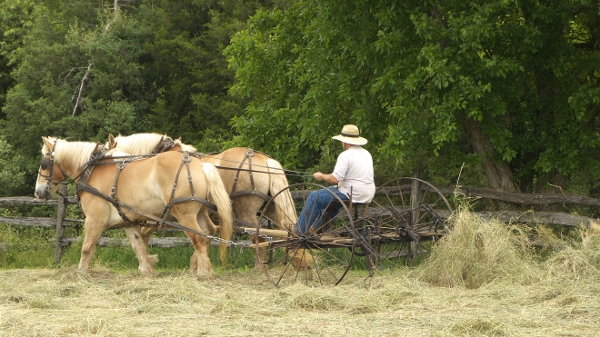
photo by Jeff Kelley, used with permission of Howell Living History Farm
An important step in making hay, tedding turns the drying grass for better, more even drying. It is done after cutting and before windrowing, and uses moving forks to aerate or "wuffle" the hay.
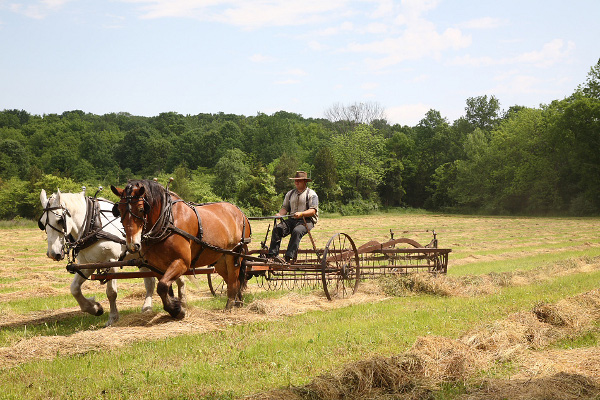
photo by Jeff Kelley, used with permission of Howell Living History Farm
The side delivery rake mounds the tedded hay into windrows.
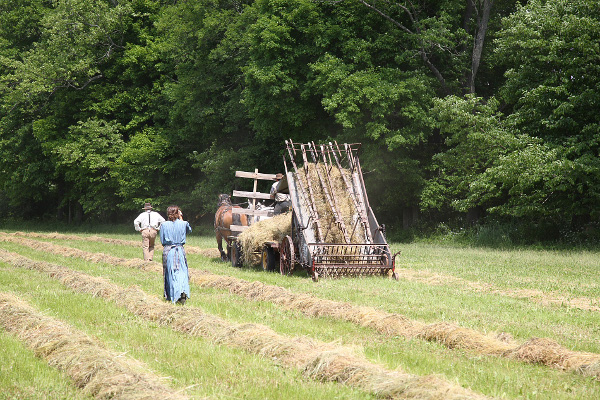
photo by Bob Thompson, used with permission of Howell Living History Farm
And the hay loader starts moving the now-dried hay onto the wagon.

photo by Bob Thompson, used with permission of Howell Living History Farm
In the days when this was a working farm (rather than an open air, living history museum) farm hands were as important as the animal traction provided by draft horses and oxen. In winter there might be four men working, in additon to the farmer and his family. And in summer, it would increase to eight full time farm laborers needed to handle all the work.

photo by Jeff Kelley, used with permission of Howell Living History Farm
Hayloader working to pile the fragrant hay.
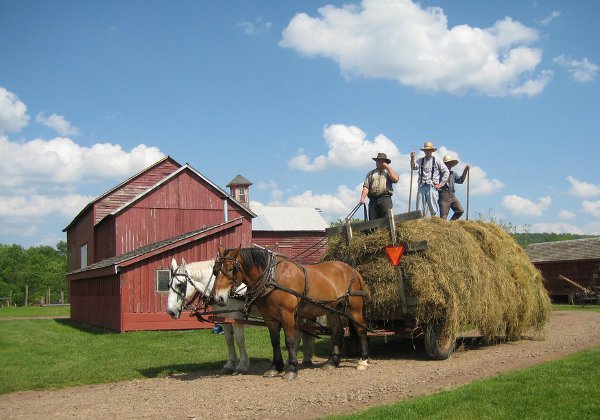
photo by Bob Thompson, used with permission of Howell Living History Farm
Into the farmyard with a load of hay.

photo by Bob Thompson, used with permission of Howell Living History Farm
And a hay fork full of hay on its way up to the mow.
Back to Top
Back to May 2016
Back to the main Diary Page